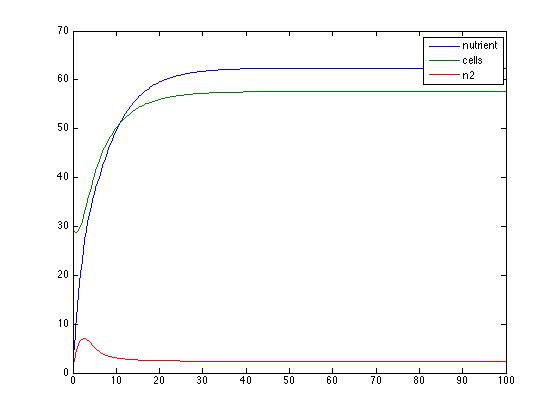Matthew E. Jurek Week 4: Difference between revisions
From OpenWetWare
Jump to navigationJump to search
(answered #2) |
(→Steady State Exercise: answered 3) |
||
| Line 146: | Line 146: | ||
[[image:page 3.pdf]] | [[image:page 3.pdf]] | ||
*As the feed rates increase, so to do the steady states. An increase in feed will increase the steady state because there are more nutrients available and thus the conversion rate is greater. | *As the feed rates increase, so to do the steady states. An increase in feed will increase the steady state because there are more nutrients available and thus the conversion rate is greater. | ||
*The dynamics will change in that the factors are added as opposed to multiplied. A decrease will be seen as the overall values will be decreased by a magnitude of order. Simply adding the values together will create lesser value than when multiplied. | |||
Revision as of 23:57, 7 February 2013
Matthew E. Jurek BIOL398-03/S13
Assignment Page
- BIOL398-03/S13:Week_2
- BIOL398-03/S13:Week 3
- BIOL398-03/S13:Week 4
- BIOL398-03/S13:Week_5
- BIOL398-03/S13:Week_6
- BIOL398-03/S13:Week_8
- BIOL398-03/S13:Week_9
- BIOL398-03/S13:Week_11
- BIOL398-03/S13:Week_12
- BIOL398-03/S13:Week_13
- BIOL398-03/S13:Week_14
User Page
- Matthew E. Jurek Week 2
- Matthew E. Jurek Week 3
- Matthew E. Jurek Week 4
- Matthew E. Jurek Week 5
- Matthew E. Jurek Week 6
- Anthony J. Wavrin/Matthew E. Jurek Metabolic Pathways Project
- Matthew E. Jurek Week 8
- Matthew E. Jurek Week 9
- Matthew E. Jurek Week 11
- Matthew E. Jurek Week 12
- Matthew E. Jurek Week 13
- Matthew E. Jurek Week 14
- Final Presentation
Given Conditions
| Parameter | Parameter Value |
|---|---|
| q | 0.15 |
| un | 120 |
| r | 1.0 |
| K | 5 |
| v | 0.5 |
| uc | 60 |
Change in Q
| Parameter | Parameter Value |
|---|---|
| q | 0.25 |
| un | 120 |
| r | 1.0 |
| K | 5 |
| v | 0.5 |
| uc | 60 |
Change in un
| Parameter | Parameter Value |
|---|---|
| q | 0.15 |
| un | 200 |
| r | 1.0 |
| K | 5 |
| v | 0.5 |
| uc | 60 |
Change in r
| Parameter | Parameter Value |
|---|---|
| q | 0.15 |
| un | 120 |
| r | 2.0 |
| K | 5 |
| v | 0.5 |
| uc | 60 |
Change in K
| Parameter | Parameter Value |
|---|---|
| q | 0.15 |
| un | 120 |
| r | 1.0 |
| K | 10 |
| v | 0.5 |
| uc | 60 |
Change in V
| Parameter | Parameter Value |
|---|---|
| q | 0.15 |
| un | 120 |
| r | 1.0 |
| K | 5 |
| v | 1.0 |
| uc | 60 |
Change in uc
| Parameter | Parameter Value |
|---|---|
| q | 0.15 |
| un | 120 |
| r | 1.0 |
| K | 5 |
| v | 0.5 |
| uc | 30 |
Steady State Exercise
File:Page 1.pdf File:Page 2.pdf File:Page 3.pdf
- As the feed rates increase, so to do the steady states. An increase in feed will increase the steady state because there are more nutrients available and thus the conversion rate is greater.
- The dynamics will change in that the factors are added as opposed to multiplied. A decrease will be seen as the overall values will be decreased by a magnitude of order. Simply adding the values together will create lesser value than when multiplied.






